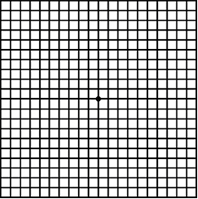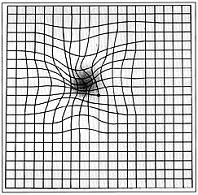This simple screening tool is used for monitoring for early signs of wet AMD. The Amsler test consists of a grid of evenly spaced horizontal and vertical lines. A small dot is located in the center of the grid for the person taking the test to focus on. While staring at the dot, the person will look for wavy lines and missing areas of the grid. This test is especially helpful for monitoring vision at home.
The Amsler Grid is not a substitute for regularly scheduled eye exams, which should take place at least once every two years, and at least once a year after the age of 50. (You may need them even more often depending on your risk factors for AMD.)
However if you are concerned about AMD, and particularly if you have a family history, you are over 50, or you have other risk factors for the disease, you are encouraged to do the Amsler test on a regular basis. Place an Amsler grid on your fridge or in another location you see often. This way, you will be reminded to look at the test on a daily basis.
Test Instructions
- Download the Amsler Grid (PDF Format)
- Make sure you are in an area with good lighting, and hold or post the chart at eye level and at a comfortable distance. You may find it convenient to attach the grid to a wall at and stand 12 inches to 14 inches away (generally a comfortable reading distance).
- If you wear glasses, keep them on. If you wear bifocals, use the bottom or reading portion of the lens.
- Cover one eye and look at the dot in the center of the grid. Note how the lines and squares appear and whether or not there are any distortions or breaks in the lines of the grid. Also note if the centre dot, a part of the dot, or any of the lines disappear. Blurred or double images might not necessarily be abnormal. The use of progressive, lineless bifocals may introduce some distortion in the grid.
- Test the other eye in the same way.
- The whole process may take only 10 seconds. Check the grid daily, or as often as recommended by your eye care professional.
Remember, if you experience any of these changes, make an appointment with your eye care specialist immediately:
• Blurring or grey areas
• Distortion or wavy lines
• Holes or spots in any areas of the grid
If you already have wet AMD
People who have already been diagnosed with wet AMD should use the grid every day to check for changes in vision. On the first day, mark any areas of distortion, any grey or blurry areas, or any blank spots with a pencil directly on the grid. This will be your baseline pattern for that eye. (You should keep a separate grid for each eye.) Each day after that, repeat the test. If you notice any new areas of distortion, new wavy lines or the enlargement of any blank spots (particularly toward the center of the grid), see your eye care specialist as soon as possible.
This is a normal Amsler Grid:

This is how it might look if you had AMD:
